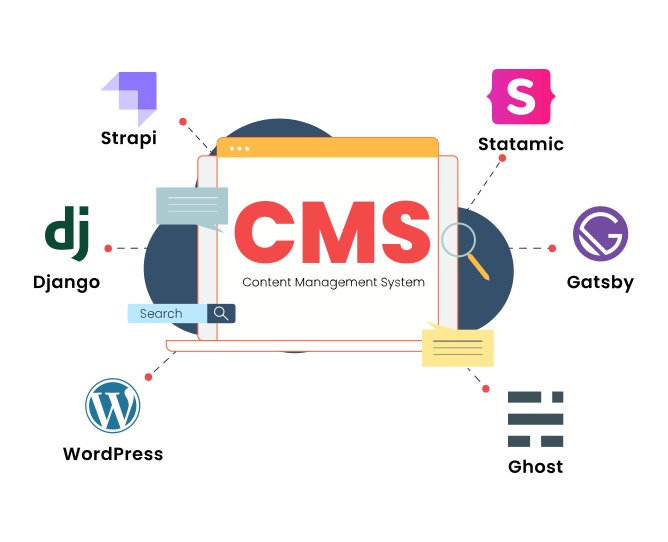Introduction
Migrating to a new Content Management System (CMS) can be daunting for any business. Whether you are a small startup or a large enterprise, transitioning to a new CMS requires careful planning and execution to ensure a smooth transition. This blog post will explore strategies to help you navigate migrating to a new CMS effectively. Whether you are considering a CMS development company or exploring CMS development services, these strategies will provide valuable insights to make your transition seamless and successful.
Pre-Migration Preparation
Proper preparation is crucial when migrating to a new content management system (CMS). In this section, we will explore the key steps involved in pre-migration preparation. Here are the important points to consider:
Evaluating the need for migration:
- Determine why you need to migrate to a new CMS.
- Assess if your current CMS needs to meet your requirements.
- Identify specific pain points or limitations that necessitate a change.
Defining migration goals and objectives:
- Establish what you aim to achieve with the migration.
- Define your objectives, such as improving website performance, enhancing user experience, or increasing efficiency.
Conducting a content audit:
- Take an inventory of your existing content.
- Analyze the quality, relevance, and organization of your content.
- Identify outdated or redundant content that can be eliminated during migration.
Assessing current CMS limitations:
- Evaluate the strengths and weaknesses of your current CMS.
- Determine the functionalities and features that are lacking or causing difficulties.
- Identify the specific areas where a new CMS can provide improvements.
Identifying potential risks and challenges:
- Anticipate any potential obstacles or risks associated with the migration process.
- Consider factors such as data loss, downtime, or compatibility issues.
- Develop contingency plans to mitigate risks and ensure a smooth transition.
Setting a realistic timeline:
- Establish a timeline that considers the complexity of your website and the migration process.
- Allocate sufficient time for planning, testing, and implementation.
- Communicate the timeline with relevant stakeholders to manage expectations.
Remember, if you're looking for assistance with CMS development, some CMS development company offer CMS development services. They can provide expert guidance and support throughout the migration process.
Choosing the Right CMS
When choosing the right CMS (Content Management System) for your website, several important factors must be considered. Let's break it down into easy-to-understand bullet points:
Researching available CMS options:
- Start by researching the different CMS options available in the market.
- Look for well-established and reputable CMS platforms that have a good track record.
Considering scalability and future needs:
- Think about the future growth of your website and the scalability requirements.
- Choose a CMS that can accommodate your website's growth and handle increased traffic.
Evaluating ease of use and user-friendliness:
- Consider the ease of use of the CMS, especially if you need to be more tech-savvy.
- Look for a CMS with a user-friendly interface and intuitive features.
Analyzing available features and functionalities:
- Make a list of features and functionalities you require for your website.
- Compare different CMS options to see which one offers the features you need.
Assessing technical requirements and compatibility:
- Consider the technical requirements of your website, such as hosting and server compatibility.
- Ensure that the CMS you choose is compatible with your technical infrastructure.
Seeking recommendations and reviews:
- Ask for recommendations from colleagues or friends who have experience with CMS platforms.
- Read reviews and testimonials from other users to understand their experiences.
Remember to reach out to a CMS development company or avail of CMS development services to assist you in selecting and implementing the right CMS for your website. They can provide professional guidance and expertise to ensure a smooth CMS development process.
By following these steps and considering these factors, you can make an informed decision and choose the right CMS that meets your website's requirements and aligns with your business goals.
Planning the Migration Process
Creating a detailed migration plan:
- Define the objectives and scope of the migration.
- Identify the current CMS system and the desired CMS platform.
- Set a timeline for the migration process.
- Determine the resources required for the migration, such as personnel, tools, and budget.
- Document the steps involved in each phase of the migration.
Assigning roles and responsibilities:
- Identify key stakeholders and assign roles to team members.
- Define responsibilities for each team member involved in the migration.
- Ensure clear communication channels to facilitate collaboration and problem-solving.
Establishing a backup and contingency plan:
- Create backups of the current CMS system and website content.
- Develop a plan to handle unforeseen challenges or issues during the migration.
- Define backup procedures to mitigate data loss or system downtime.
Defining data migration strategies:
- Analyze the data structure of the existing CMS and map it to the new CMS.
- Determine how to migrate various data types, including content, media files, user information, and metadata.
- Plan the data transformation and validation processes.
- Consider data security and privacy aspects during the migration.
Mapping content structure and URLs:
- Analyze the existing content structure and URL hierarchy.
- Map the content structure to the new CMS, ensuring proper organization and navigation.
- Develop URL redirection strategies to maintain search engine rankings and minimize broken links.
Testing the new CMS environment:
- Set up a test environment to validate the migrated content, functionality, and performance.
- Conduct thorough testing of different features, plugins, and integrations.
- Involve end-users or stakeholders in the testing process to gather feedback and address issues.
Executing the Migration
This section will cover the steps involved in executing the migration process from one content management system (CMS) to another. It's important to follow these steps carefully to ensure a smooth transition. Here's a breakdown of the key tasks involved:
Backing up existing CMS data:
- Before making any changes, backup your current CMS data to avoid potential loss or damage.
- This step ensures you have a safe copy of your content if anything goes wrong during the migration process.
Exporting content from the current CMS:
- Use the export functionality your current CMS provides to extract all the relevant content, including pages, posts, images, and other media files.
- This exported content will be used later to import into the new CMS.
Importing content into the new CMS:
- It's time to import the content you exported from the old CMS into the new CMS.
- The new CMS may have an import feature that allows you to bring in the exported content.
- Follow the instructions provided by the new CMS to complete this step successfully.
Validating data integrity and accuracy:
- After importing the content, thoroughly check the data for inconsistencies, errors, or missing elements.
- Ensure all the content, including text, images, and links, has been transferred correctly.
- Validate the data against your backup to ensure everything is intact.
Redirecting URLs and managing SEO:
- During the migration, URLs of your website may change, affecting search engine rankings and user experience.
- Implement 301 redirects to redirect old URLs to their new counterparts.
- Update internal links within your content to point to the new URLs.
- Please inform search engines about the changes through webmaster tools or sitemaps.
Testing functionality and user experience:
- After completing the migration and ensuring the data is accurate, thoroughly test the functionality of your new CMS.
- Ensure all pages load correctly, forms work, and any custom functionalities function as expected.
- Test the website's user experience to ensure smooth navigation, readability, and responsiveness across different devices.
Conclusion
Migrating to a new CMS is a significant undertaking, but it can be a smooth and successful transition with the right strategies in place. By carefully planning your migration, considering the expertise of a CMS development company, and leveraging CMS development services, you can ensure minimal disruption to your website or application. Remember to thoroughly assess your needs, conduct proper testing, and have a solid backup plan in case any issues arise during the migration process. With the right approach and attention to detail, you can seamlessly transition to a new CMS and unlock the full potential of your digital presence.


No comments yet